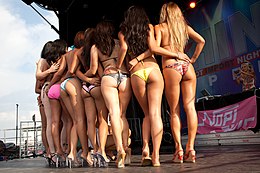Sexual objectification

Sexual objectification is the act of treating a person solely as an object of sexual desire. Objectification more broadly means treating a person as a commodity or an object without regard to their personality or dignity. Objectification is most commonly examined at the level of a society, but can also refer to the behavior of individuals and is a type of dehumanization.
Although both males and females can be sexually objectified, the concept is mainly associated with the objectification of women, and is an important idea in many feminist theories and psychological theories derived from them. Sexual objectification of girls and women contributes to gender inequality, and many psychologists associate objectification with a range of physical and mental health risks in women.
Sexual objectification of women
General
The sexual objectification of women involves them being viewed primarily as an object of male sexual desire, rather than as a whole person.[1][2][3] Although opinions differ as to which situations are objectionable, many see objectification of women taking place in the sexually oriented depictions of women in advertising, art and media, pornography, the occupations of stripping and prostitution, and women being brazenly evaluated or judged sexually or aesthetically in public spaces and events, such as beauty contests.[4]
Some feminists and psychologists[5] argue that sexual objectification can lead to negative psychological effects including eating disorders, depression and sexual dysfunction, and can give women negative self-images because of the belief that their intelligence and competence are currently not being, nor will ever be, acknowledged by society.[3] Sexual objectification of women has also been found to negatively affect women's performance, confidence, and level of position in the workplace.[citation needed] How objectification has affected women and society in general is a topic of academic debate, with some saying girls' understanding of the importance of appearance in society may contribute to feelings of fear, shame, and disgust during the transition to womanhood,[6] and others saying that young women are especially susceptible to objectification, as they are often taught that power, respect, and wealth can be derived from one's outward appearance.[7]
Pro-feminist cultural critics such as Robert Jensen and Sut Jhally accuse mass media and advertising of promoting the objectification of women to help promote goods and services,[4][8][9] and the television and film industries are commonly accused of normalizing the sexual objectification of women.[10]
The objection to the objectification of women is not a recent phenomenon. In the French Enlightenment, for example, there was a debate as to whether a woman's breasts were merely a sensual enticement or rather a natural gift. In Alexandre Guillaume Mouslier de Moissy's 1771 play The True Mother (La Vraie Mère), the title character rebukes her husband for treating her as merely an object for his sexual gratification: "Are your senses so gross as to look on these breasts – the respectable treasures of nature – as merely an embellishment, destined to ornament the chest of women?"[11]
The issues concerning sexual objectification became first problemized during the 1970s by feminist groups. Since then, it has been argued that the phenomenon of female sexual objectification has increased drastically since its problematization in all levels of life, and has resulted in negative consequences for women, especially in the political sphere. However, a rising form of new third-waver feminist groups have also taken the increased objectification of women as an opportunity to use the female body as a mode of power.[12]
Some have argued that the feminist movement itself has contributed to the problem of the sexual objectification of women by promoting "free" love (i.e. men and women choosing to have non-reproductive sex outside of marriage and for their own pleasure).[5][13] One study found that men exposed to media content in which women were objectified were more likely to accept those behaviors than men who were exposed to content where women were not objectified.[14]
Female self-objectification

Ariel Levy contends that Western women who exploit their sexuality by, for example, wearing revealing clothing and engaging in lewd behavior, engage in female self-objectification, meaning they objectify themselves. While some women see such behaviour as a form of empowerment, Levy contends that it has led to greater emphasis on a physical criterion or sexualization for women's perceived self-worth, which Levy calls "raunch culture".[15]
Levy discusses this phenomenon in Female Chauvinist Pigs: Women and the Rise of Raunch Culture. Levy followed the camera crew from the Girls Gone Wild video series, and argues that contemporary America's sexualized culture not only objectifies women, it encourages women to objectify themselves.[16] In today's culture, Levy writes, the idea of a woman participating in a wet T-shirt contest or being comfortable watching explicit pornography has become a symbol of feminist strength.
Jordan Peterson has asked why women need to wear make-up or high-heels in the workplace, that a double standard exists for sexual harassment and females who self-objectify themselves in s


Keine Kommentare:
Kommentar veröffentlichen